#Diamond Jubilee of Elizabeth II (2012)
Text
Catherine, Duchess of Cambridge attending a Service of Thanksgiving to celebrate Queen Elizabeth II's Diamond Jubilee at St Paul's Cathedral on June 5, 2012 in London, England.








#kate middleton#duchess of cambridge#queen elizabeth ii#diamond jubilee#london#2012#british royal family#st pauls cathedral#royal family#british royal fandom#catherine princess of wales#princess kate
50 notes
·
View notes
Text

A flotilla of watercraft followed the Queen's royal barge along the River Thames as part of Her Majesty's Diamond Jubilee celebration.
#Gloriana#Her Majesty Queen Elizabeth II#Diamond Jubilee#Royal Regatta#Prince Philip#Duke & Duchess of Cambridge#British royals#River Thames#London#nostalgia#June 2012
6 notes
·
View notes
Text
The Coronation Chair: Anatomy of a Medieval throne
The Diamond Jubilee of Queen Elizabeth II prompted the first comprehensive archaeological study of the Medieval throne on which British monarchs are crowned.
It has been battered and vandalised over the ages, but unpicking this majestic artefact’s evolution shed new light on both its original form and that of the enigmatic Stone of Scone, as Warwick Rodwell reveals.
10 August 2013
The Coronation Chair has been illustrated and described since the 14th century, and is renowned the world over.
For hundreds of years, this piece of Medieval furniture has played a seminal role in the anointing and crowning of English monarchs.
It was last used at the coronation of HM The Queen on 2 June 1953, the Diamond Jubilee of which was celebrated this year.
To mark the occasion in 2010-2012, the Chair underwent a long-overdue programme of cleaning, conservation and redisplay in Westminster Abbey.
Concurrently, a detailed archaeological study was carried out and the Chair was comprehensively recorded for the first time.
The project led to a radically new understanding of its construction and decoration, and of its relationship to the Stone of Scone, which was embodied in its seat.
Spoils of war
The origins of the Chair are well known. Indeed, the documentation accompanying its manufacture in the 1290s is still preserved.
Following Edward I’s victory over the Scots in 1296, state documents and items of regalia were surrendered and taken to London as spoils of war.
One of those items was a ceremonial block of sandstone upon which Scottish kings had hitherto been inaugurated at Scone Abbey in Perthshire, the last being John Balliol in 1292.

The Coronation Chair and Stone of Scone.
Constructed in the 1290s on the orders of Edward I, this famous throne recently received its first comprehensive archaeological study.
The results emphasise how the current form of the Stone of Scone can only be understood alongside the evolution of the chair that held it.
Edward I treated the Stone of Scone as a relic and presented it, along with the Scottish crown and sceptre, to the shrine of St Edward the Confessor in Westminster Abbey on 18 June 1297.
He ordered the construction of a great gilt-bronze chair to incorporate the Stone as its seat.
The chair was cast but was scrapped before it was finished and a new one made of oak, thereby reducing its weight from three-quarters of a ton to one-quarter.
St Edward’s Chair, as it is properly known (‘Coronation Chair’ is a relatively recent naming), was designed as a liturgical furnishing that would stand close to the shrine altar, where it served as a seat for priests officiating at masses.
Opinion is divided as to when the Chair was first used in the coronation ritual, but it was no later than 1399, when Henry IV was crowned.
A manuscript illustration of the coronation of Edward II in 1308, however, shows the king seated in what is almost certainly the Coronation Chair.
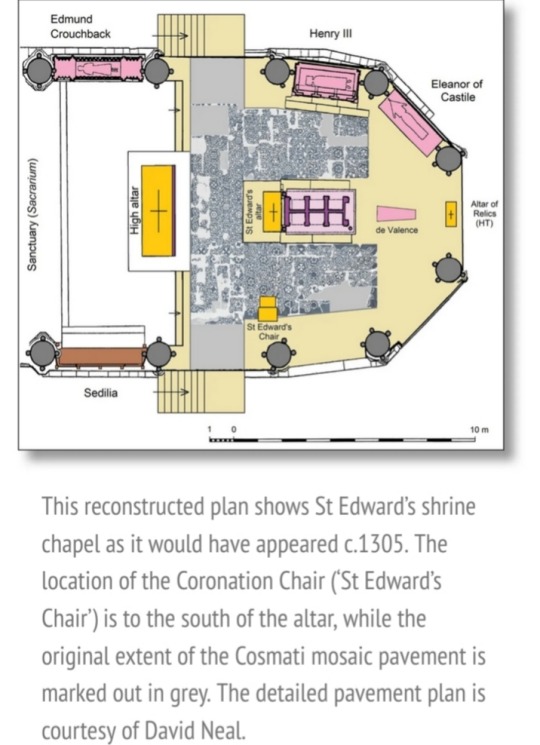
It is an extraordinary fact that, like a surprising number of artefacts and structures of first-rank importance, the Coronation Chair had never been systematically studied and recorded until now.
John Carter’s sketches of 1767 provided the basis for all known drawings but neither he nor any other antiquary recorded how the Chair was constructed or unravelled the vicissitudes of its later history.
Like most ancient artefacts of complex construction, it has undergone fundamental alterations as well as suffered deterioration over the centuries.
In fact, very little has been written about the Chair at all, as opposed to the Stone that it encapsulated.
The Chair has been the subject of a dozen books, scores of articles, Parliamentary debates, a commercial film, theft, hoaxes, and much political posturing.
Myths and misdirection
The Stone has accrued a huge mythology, but that is wholly of Medieval or later invention, as Nick Aitchison demonstrated in his study Scotland’s Stone of Destiny (2000).
The block is made of Lower Old Red Sandstone and has a geological signature that confirms it derives from the Scone Formation.
It did not originate in Egypt, Ireland or the west of Scotland, as the Romantic tales would have led us to believe.
Indeed, the Stone’s spurious biblical connection (as ‘Jacob’s Pillow’ – the stone on which, according to the Book of Genesis, the sleeping Jacob had a vision) was already being ridiculed in 1600 by William Camden.
Much of the Stone’s pseudo-history is of even more recent invention.
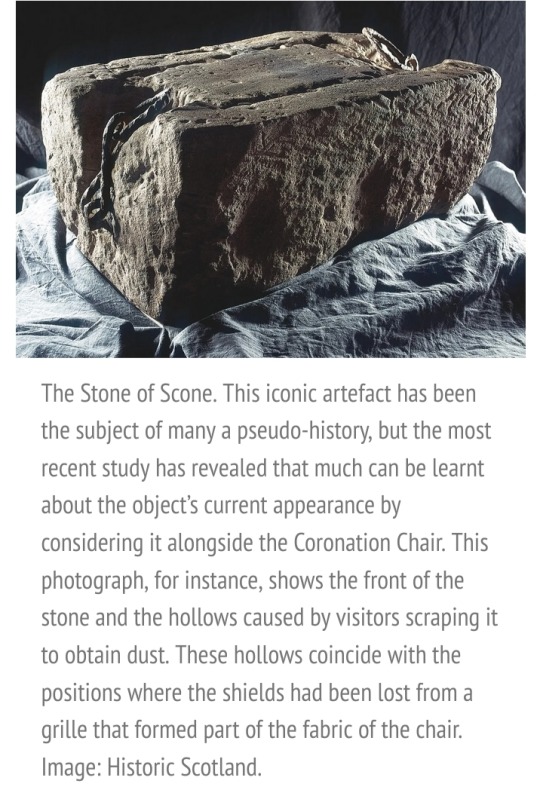
The first archaeologically objective study of the Stone took place in 1996, when it was removed from the Coronation Chair and sent to Edinburgh Castle, where it currently resides on loan from the Crown.
Under the direction of David Breeze and Richard Welander, Historic Scotland carried out a detailed examination, the findings of which were published by the Society of Antiquaries of Scotland: The Stone of Destiny: artefact and icon (2003).
The Stone’s intimate relationship to the Chair has never been explored, however, resulting in the wholly unwarranted assumption by past commentators that the physical features exhibited by the block today relate to its pre-1296 history in Scotland.
This in turn has given rise to the invention of historical scenarios to explain these features.
Some writers have pronounced the block to be a Roman building stone or part of a pagan altar; others have claimed a Bronze Age or Pictish ancestry.
The iron links and rings that are attached to the two ends of the block have given rise to much comment, as well as claims that they were inserted for the purpose of carrying the Stone from site to site in Scotland, or alternatively for transporting it to London.
Finally, there are the conspiracy theorists who would have us believe that the Stone is fake.

These contentions can be refuted without exception. When we study the Chair and the Stone as archaeological artefacts, not just individually but jointly, and marry the findings with reliable historical evidence, a clear picture emerges.
The most fundamental misapprehension is that the Stone (as we see it today) was brought from Scone and placed in a made-to-measure compartment under the seat of the Chair, and that it simply sat there for the next 700 years.
In reality, the Chair and the Stone were made for one another, and both have been subjected to significant change over the centuries.

Made for each other
There is no basis for casting doubt on the authenticity of the Stone of Scone, or for claiming it as a Roman ashlar or a Pictish symbol-stone.
The upper and lower faces are natural bedding planes and are untooled, although the former is well worn through its prolonged use as a seat.
The four vertical edges were all crisply dressed in 1297 to create a close-fitting, rectangular seat for the new Chair.
One of the revelations of the 2010 study was the fact that the Coronation Chair did not have a wooden seat-board until the 16th or 17th century: the Stone itself was the seat.
The Chair frame is made of oak and comprises four corner-posts, and a series of moulded horizontal rails.
The sides of the Chair have upswept arms, which were originally decorated with carved lions.
The joints are mortised-and-tenoned but are inherently weak. The frame gets its structural strength from the lining of thick planks.
Below seat level, the sides are pierced by large quatrefoils – that is, four partially overlapping circles creating a shape akin to a stylised four-leaf clover – each of which originally had a painted heraldic shield at its centre.
By the 1820s, the shields had all been lost, and the quatrefoil grille at the front had gone too.
The gang that stole the Stone in 1950 also smashed the front rail and further weakened the frame. A replacement grille has now been fitted to restore its structural strength.
The Stone of Scone rested in this compartment and could be glimpsed on all sides; its top was fully exposed.

William Lethaby’s 1906 reconstruction of the gilt figure of a king in the back of the Chair. He is depicted seated on a low throne, with his feet resting on a lion. Only the lower part of this image survives today.
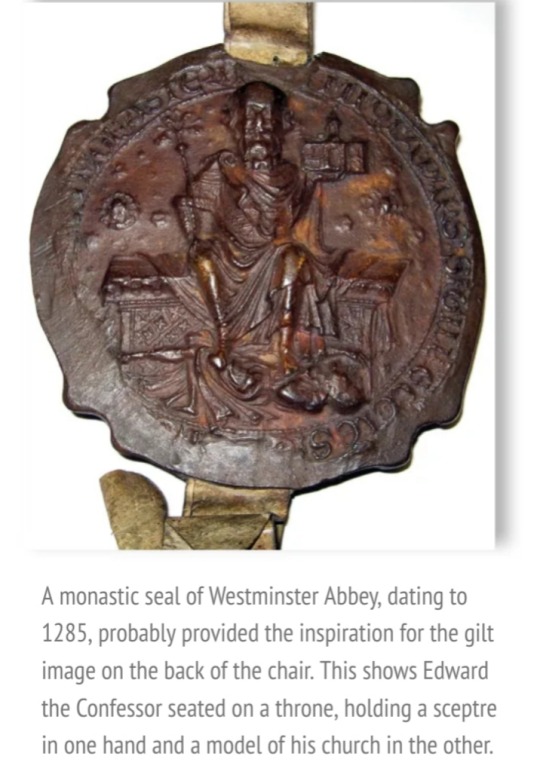
Externally, the sides and back of the Chair were carved and moulded with Gothic arcades.
The corner-posts too were embellished with blind, pointed – lancet – arches, and surmounted by pinnacles from which decorative foliage or ‘crockets’ sprouted.
No timber was originally visible, though, as the surfaces were entirely covered with decoratively punched gilding and pseudo-enamels.
There were also many pieces of coloured glass inlaid into the carved decoration. These inserts would have carried painted and gilded motifs, similar to those found in profusion on the altarpiece of Henry III known as the Westminster Retable (c. 1270).
Internally, the Chair was uncarved but was covered with gold leaf. It bore finely punched decoration - showing birds, animals, vegetation, and Gothic motifs.
Dominating the centre of the back was the seated figure of a king with his feet resting on a lion, almost certainly Edward the Confessor.
It was the work of Walter of Durham, principal painter to the court of Edward I. Unfortunately, most of this impressive display has been lost over time.
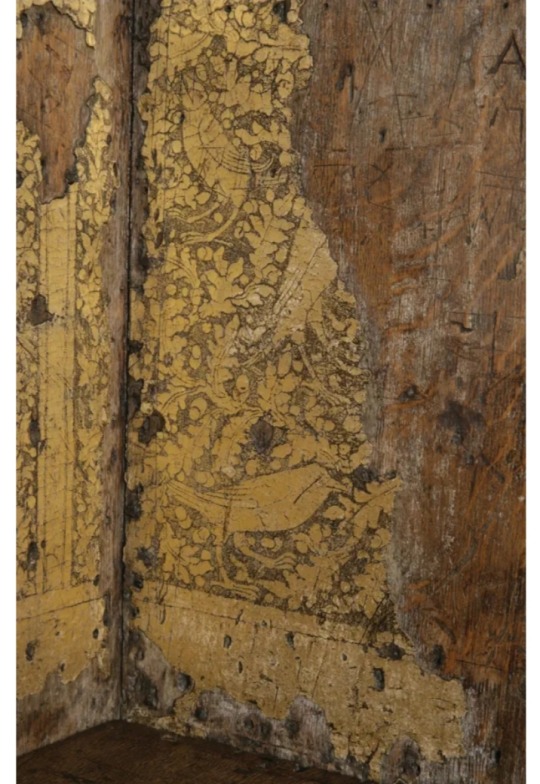
A detail of the punch-decorated gilding surviving inside the Chair’s left arm, showing birds amid vegetation.
The conservation programme of 2010-2012 was undertaken by Marie Louise Sauerberg, then of the Hamilton Kerr Institute, but now Westminster Abbey’s Senior Conservator.
Her work was key to unlocking the history of the Chair’s decoration, particularly by demonstrating that the all-over gilded appearance was primary.
In the 1950s, it had been suggested that the Chair was initially white in colour, emulating King Solomon’s ivory throne.
Royal pride
Perhaps the most striking aspect of the Coronation Chair today is the gilt plinth on which it is raised, comprising four magnificent lions with Oriental features.
These were fitted in 1727 by the royal furniture-maker for the coronation of George II and replaced an earlier plinth, which also incorporated lions.
That plinth may have been made in 1509 for the coronation of Henry VIII.
Since both lion-plinths were fixed to the Chair frame, the Stone could only be inserted into the seat compartment from above, but this was not the original arrangement.
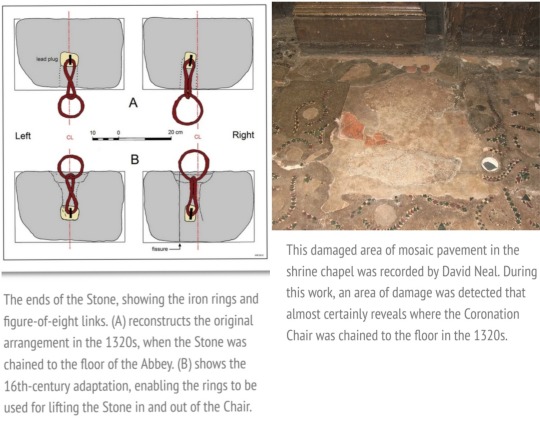
Walter of Durham’s exquisite gilt decoration would have been wrecked by manhandling a close-fitting, 3-cwt block of sandstone through the seat compartment.
Every time the Chair was required for a coronation, it had to be taken from the Confessor’s chapel through a narrow doorway, carried down steps, and repositioned in the Abbey.
Four operations were involved in extricating and replacing the Stone.
Almost certainly, the original plinth was a separate construction that rested on the floor. The Stone was placed on it and the Chair lowered over that.
Iron links and rings are attached to the ends of the Stone by staples set into lead plugs.
Various theories about their date and purpose have been advanced, all based on the assumption that they were used for lifting or carrying.
But nobody seems to have noticed that their fixing points are below the Stone’s centre-of-gravity, which means that it would instantly rotate when lifted.
Also, the links are not long enough for the rings to clear the top of the Stone, making it impossible to thread a carrying-pole of adequate diameter through them.
It is now clear that the ironwork was attached to the block in c. 1324-1327, on the instruction of Abbot Curtlyngton, expressly for the purpose of chaining it to the floor of the chapel.
At the time, he was under pressure from Edward III to relinquish the Stone so that it could be used as a bargaining counter with the Scots.
The abbot refused and the chronicler Geoffrey le Baker tells us that ‘the stone was now fixed by iron chains to the floor of Westminster Abbey under the royal throne’.
Since enforced removal of an object gifted to a shrine would have constituted sacrilege, the king backed down.
The 13th-century marble and glass mosaic pavement in the Shrine chapel has been meticulously recorded by David Neal.
During his work, we noticed that a square area to the south of the altar, where the mass priest’s seat would have stood, had been destroyed.
Almost certainly, this marks the place where the pavement was broken through in the 1320s to embed anchors in the floor for the chains that secured the Stone.

When the Chair was fitted with the first of the lion plinths, a new means of manoeuvring the Stone in and out of the seat compartment had to be found: the only route was from above.
The iron fittings were now pressed into service as lifting devices. Channels were crudely cut into the ends of the Stone so that the links could stand up, rather than hang down, and ropes could be passed through the rings.
The tendency for the unbalanced Stone to rotate was largely mitigated by the links being constrained in channels.
It was a clumsy compromise but it worked, albeit inflicting damage on the gilded interior of the Chair, as the Stone was hauled in and out.
The institutional history of Westminster Abbey in the two decades following its dissolution in 1540 is complex, but remarkably, the shrine of St Edward and the royal tombs survived.
The later 16th century saw a fashion for attaching historical labels (tabulae) to features around the Abbey, including the shrine, tombs and St Edward’s Chair.
These were generally painted either directly on the object or on a board, but in the case of the Chair, it seems that there was initially an intention to insert an inscribed brass plate in the upper face of the Stone.
The rectangular outline for the plate was roughly chiselled. The matrix was never fully cut and the project aborted. A painted label on a board was provided instead.
The change of plan most likely resulted from a decision to fit a timber seat-board over the Stone that had two further consequences.
First, battens had to be fitted to the sides of the Chair to support the seat-board, thereby reducing the size of the Stone compartment opening.
The block had to be shortened, and both ends were cut back by c. 15mm.
Second, the iron rings projected above the top of the Stone, obstructing the fixing of the seat.
To solve this problem, housings were hacked into the top of the Stone, allowing the rings to lie flat.
13th-century survival
Since the late 16th century, travellers and antiquaries have written accounts of the Chair, from which we learn that it suffered casual abuse until Queen Victoria came to the throne.
All the glass inserts were prised out, scores of slices were removed from the frame with pocket-knives and taken as souvenirs, names and initials were liberally carved in the wood, and the shields were stolen from the quatrefoils, exposing the sides of the Stone, which was then scraped with knives to acquire samples of its dust.
Three shallow scoops scored into the front edge result from this activity.
In the 18th century, when the second lion-plinth and new seat-board were fitted, further modifications to both the Chair and Stone occurred.
Although the latter had been shortened, the iron staples to which the rings were attached projected awkwardly, gouging the sides of the Chair every time the Stone was moved.
To ease this, the crowns of the staples were filed down. Something even more barbaric happened between 1727 and 1821: the lower edges of the Stone were broken away with nine hammer-blows.
There is no obvious explanation for this – perhaps the pieces were sold as souvenirs.
Even in more recent times, the Chair has suffered periodically.
In 1887, the Office of Works painted it brown for the celebration of Queen Victoria’s Golden Jubilee.
A public outcry ensued and great damage was done to the gilt decoration when trying to remove the paint.
In 1914, Suffragettes attached a home-made bomb to one of the Chair’s pinnacles, causing more damage.
In 1939-1945, the Chair was stored in the crypt of Gloucester Cathedral, where it narrowly escaped destruction by an infestation of dry rot.
Finally, as well as vandalising the Chair, the gang that stole the Stone in 1950 dropped it and broke it.
Given this long and varied history, it is perhaps remarkable that the Chair survives at all.
Yet our study makes it clear that, despite having fallen victim to neglect, politics and the whims of fashion, St Edward’s Chair and the Stone of Scone – in the form we know it today – are two components of a single artefact, made in the 1290s.
They have an integrated physical history, and shared archaeology: one cannot be understood without the other.
#Coronation Chair#St Edward's Chair#King Edward's Chair#Stone of Scone#Coronation Stone#King Edward I#British History#British Royal Family#Queen Victoria#Queen Elizabeth II#medieval throne#Golden Jubilee of Queen Victoria (1887)#Diamond Jubilee of Elizabeth II (2012)
52 notes
·
View notes
Text
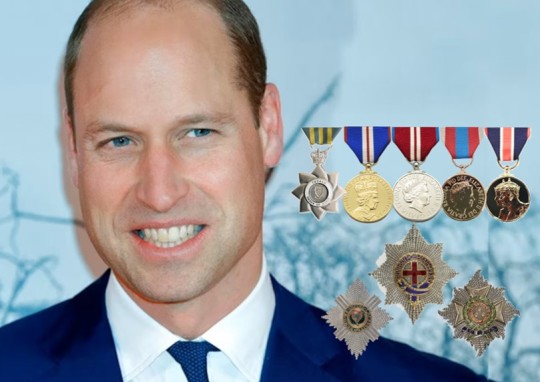
The Medals of HRH the Prince of Wales
Yesterday HM the King appointed his son and heir the Grand Master and senior Knight Grand Cross of the Most Honourable Order of the Bath. here is the full list of his Orders and Medals
Knight Garter (KG) appointed by his Grandmother Queen Elizabeth II in 2008
Knight of the Order of the Thistle (KT) by his Grandmother in 2012
Knight Grand Cross of the Most Honourable Order of the Bath (GCB) by his father King Charles III yesterday
Member of the Tuvalu Order of Merit in 2016 by Sir Iakoba Taeia Italeli the Governor General of Tuvalu
He also holds the late Queen's Golden, Diamond and Platinum Jubilee Medals, along with his Father's 2023 Coronation Medal.
34 notes
·
View notes
Text
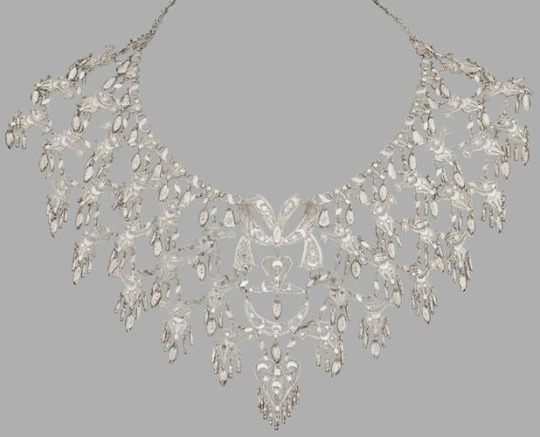
Parure of silver jewellery. The style is traditionally worn by Yemeni Jewish women.

Presented to Queen Elizabeth II by President Abdrabbuh Mansour Hadi of the Republic of Yemen, on the occasion of her Diamond Jubilee, 6 July 2012.

~ RCT
#source;royal collection trust#british royal family#queen elizabeth ii#official gift#jewel;necklace#jewel;earrings#jewel;bracelet#thejewelcatalogue
41 notes
·
View notes
Text

1 March 2012 | Queen Elizabeth II views a display of iced cakes while visiting Fortnum & Mason store in London, England. Together with Camilla, Duchess of Cornwall and Catherine, Duchess of Cambridge, Queen Elizabeth II met military personnel and staff, viewed the store's Diamond Jubilee product ranges and unveiled a plaque for the restoration of Piccadilly. (c) Toby Melville - WPA Pool/Getty Images
48 notes
·
View notes
Text
New ceremonial details about the Coronation of The King and The Queen Consort, posted by the Royal Family account:
On the morning of the Coronation, Their Majesties will travel from Buckingham Palace in The King’s Procession to Westminster Abbey in the Diamond Jubilee State Coach – which was created in 2012 for Queen Elizabeth II’s Diamond Jubilee.
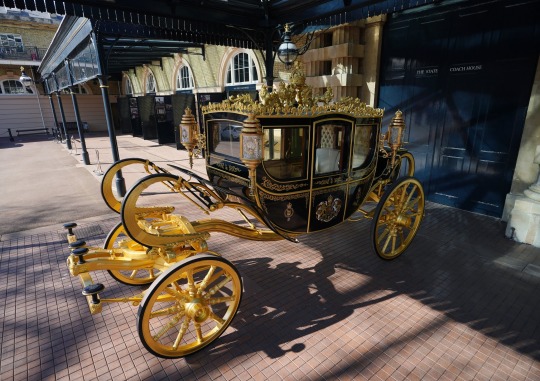
The King’s Procession, accompanied by The Sovereign’s Escort of the Household Cavalry, will depart Buckingham Palace and proceed down The Mall, passing through Admiralty Arch and Trafalgar Square, down Whitehall and along Parliament Street to Westminster Abbey.
The procession from Westminster Abbey to Buckingham Palace – The Coronation Procession - will take same route in reverse and will feature Armed Forces from across the Commonwealth and the British Overseas Territories, and all Services of the UK’s Armed Forces.
Their Majesties will travel in the Gold State Coach, which was commissioned in 1760 and was first used by King George III to travel to the State Opening of Parliament in 1762, and has been used at every Coronation since that of William IV in 1831.
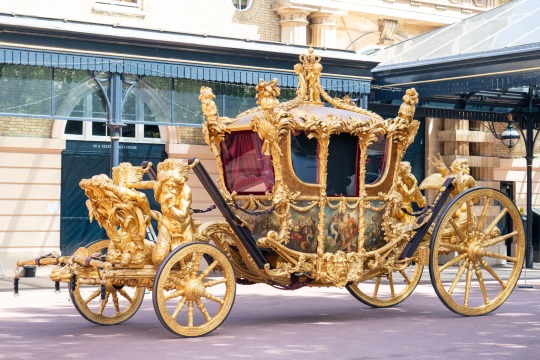
101 notes
·
View notes
Note
Silly question, is the necklace Camila wearing a tiara too?
That's not a silly question at all!

Nine times out of ten if you asked that about a fringe the answer would be that it's a convertible necklace/tiara but this is one of the rare exceptions. According to Hugh Roberts in The Queen's Diamonds, Queen Elizabeth's City of London Fringe Necklace is not convertible to a tiara. A jeweler could modify it so that it could attach to a tiara frame but the BRF haven't needed to do that because they have Queen Mary's Fringe Tiara already.
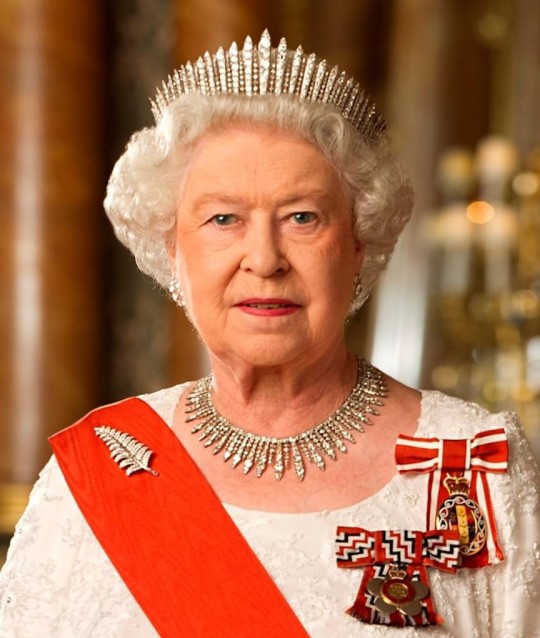
Here's Queen Elizabeth II double fringing it with Queen Mary's Fringe Tiara and her own City of London Fringe Necklace in 2012 for a diamond jubilee portrait as Queen of New Zealand.
#Tiara Talk#British Royal Family#United Kingdom#tiara#fringe tiara#Queen Elizabeth II#diamond#mintley8
116 notes
·
View notes
Text


Queen Elizabeth II and The Duchess of Cambridge on the balcony at the market square during a Diamond Jubilee visit to Nottingham in Nottingham | 13 June 2012
#british royal family#british royals#royalty#royals#brf#kate middleton#catherine middleton#duchess of cambridge#royal#princess of wales#the princess of wales#princess catherine#13.06.2012#east midlands visit 12#queen elizabeth ii#qeii#queen elizabeth#british royalty#my edit#cat cambridge#diamond jubilee#diamond jubilee 2012
61 notes
·
View notes
Text


Princess Anne and her husband, Vice Admiral Sir Tim Laurence arrive at the Simon's Town Naval Base as part of Her Majesty The Queen Elizabeth II's Diamond Jubilee celebrations, on 18 April 2012 in Cape Town, South Africa.
43 notes
·
View notes
Text

Catherine, Duchess of Cambridge attends an official dinner hosted by Malaysia's Head of State Sultan Abdul Halim Mu'adzam Shah of Kedah on Day 3 of the Diamond Jubilee Tour of South East Asia at the Istana Negara on September 13, 2012 in Kuala Lumpur, Malaysia.
#duchess of cambridge#kate middleton#diamond jubilee#malaysia#2012#queen elizabeth ii#british royal family#royal family#royal style#british royal fandom#catherine princess of wales
49 notes
·
View notes
Text
Details on the Coronation Procession
On the morning of the 6th May, Their Majesties will travel from Buckingham Palace in The King’s Procession to Westminster Abbey in the Diamond Jubilee State Coach. Created for Queen Elizabeth II to commemorate the 60th anniversary of Her late Majesty’s reign in 2012, the coach has only ever conveyed the Sovereign, occasionally accompanied by the consort or a visiting Head of State.
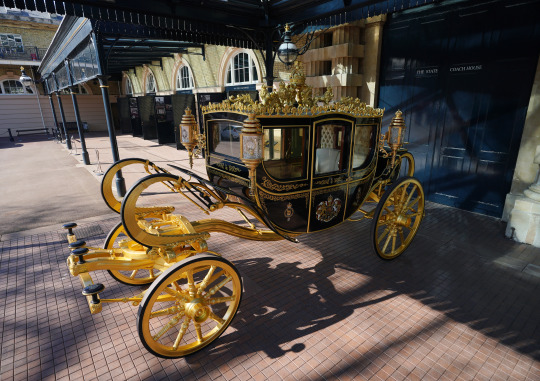
The gilded crown on the top of the Diamond Jubilee State Coach was carved from oak from HMS Victory, and the coach’s interior is inlaid with samples of woods, metals and other materials from buildings and places with specific connections to Britain and its history; Royal Residences including Buckingham Palace, Kensington Palace, Windsor Castle and the Palace of Holyroodhouse; cathedrals including St Paul’s and Westminster Abbey; and historic ships, such as the Mary Rose. The coach will be drawn by six Windsor Greys.
The King’s Procession, accompanied by The Sovereign’s Escort of the Household Cavalry, will depart Buckingham Palace through the Centre Gate, and proceed down The Mall, passing through Admiralty Arch and south of King Charles I Island, down Whitehall and along Parliament Street. The King’s Procession will travel around the east and south sides of Parliament Square to Broad Sanctuary to arrive at the Sanctuary of Westminster Abbey, where the Coronation Service will begin at 11 o’clock.

The procession from Westminster Abbey to Buckingham Palace, The Coronation Procession, will be much larger in scale, taking the same route in reverse. The Coronation Procession will include Armed Forces from across the Commonwealth and the British Overseas Territories, and all Services of the Armed Forces of the United Kingdom, alongside The Sovereign’s Bodyguard and Royal Watermen.
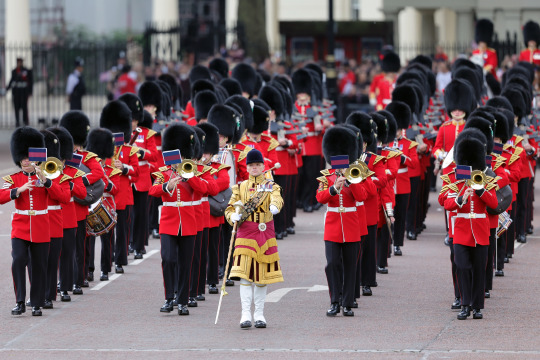
Their Majesties will travel in the Gold State Coach. The coach, last seen during the Pageant of the Platinum Jubilee of Queen Elizabeth II in June 2022, was commissioned in 1760 and was first used by King George III, to travel to the State Opening of Parliament in 1762. The coach has been used at every Coronation since that of William IV in 1831. The coach will be drawn by eight Windsor Greys and, due to its weight of four tonnes, will travel at walking pace.
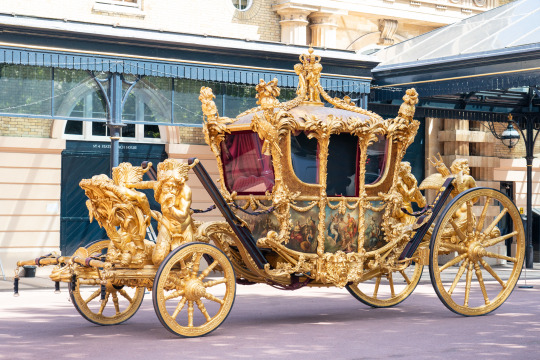
Upon returning to Buckingham Palace following the Coronation Service, Their Majesties will receive a Royal Salute from the United Kingdom and Commonwealth Armed Forces who have been on parade that day. The Royal Salute will be followed by three cheers from the assembled service personnel, as a tribute from the Armed Forces on parade to The King and The Queen Consort on the day of Their Majesties’ Coronation.
41 notes
·
View notes
Photo

Hi CC! I found the image of the consort crown on a twitter account so I didn’t make it. I don’t remember the account though.
The brooch I put in my “Catherine’s 👑 brooch choice” category is always a Cullinan but won’t be added to the consort crown so is free to be worn in its brooch form 😍
There’s a drop-shaped ring too. The biggest Cullinan in the monarch’s scepter and the second in dimension is set in the Crown.
The drop diamond in the emerald necklace I submitted in the Vladimir collage is a Cullinan too 😊
There sjould be a total of 9 if I remember well
*
Hi Nonny,
I think there are nine Cullinan diamonds as well. I think it would be fantastic if Camilla wore as many of them as possible to the coronation, to match the ones in her crown.
I looked them up and here they are:

Top Row: Cullinan II, I, and III
Bottom Row: Cullinan VIII, VI, IV, V, VII, IX
As to where they are today:
The Cullinan I is the biggest and is in the Sovereign’s Sceptre. It is also known as “The Star of Africa”.

The Cullinan II is the next biggest and is in the Imperial State Crown, below the Black Prince’s Ruby.

The Cullinan III is a pear shaped diamond and the Cullinan IV is a square diamond. Together, they make up the brooch known as ‘Granny’s Chips’.

These two stones are going to be set in Queen Mary’s Crown for Camilla to wear at the Coronation, as per the picture in the submitted post above.
The Cullinan V is the heart shaped or triangular diamond set in a scroll brooch.

This diamond is going to be set in Queen Mary’s crown for Camilla to wear at the Coronation, as per the picture in the submitted post above.
The Cullinan VI is a marquise cut diamond. Queen Elizabeth II wore it as a pendant from another brooch with the Cullinan VIII diamond.

I can’t find a picture of Her Late Majesty wearing this brooch that shows it clearly.
The Cullinan VII diamond is also a marquise cut diamond, and it is part of the Delhi Durbar necklace, as a pendant next to the emerald.

The Cullinan VIII diamond is a rectangular diamond set in a scroll brooch that looks very similar to the brooch with the Cullinan V diamond. The Cullinan VI diamond is suspended as a pendant from the Cullinan VIII brooch.

The Cullinan XI diamond is pear shaped and is set in a ring. Again, I can’t find a picture of Her Late Majesty wearing this ring where the ring is clear to see.

In summary, here are the nine Cullinan diamonds in their settings:

References:
pinterest.com
https://queensjewelvault.blogspot.com/2013/05/the-cullinan-vi-and-viii-brooch.html
http://orderofsplendor.blogspot.com/2012/04/cullinans-part-4-pendant-brooch.html
http://orderofsplendor.blogspot.com/2012/04/queens-top-10-diamonds-1-cullinan.html
https://www.rct.uk/collection/themes/Trails/the-crown-jewels-coronation-regalia
https://www.rct.uk/collection/themes/exhibitions/diamonds-a-jubilee-celebration/buckingham-palace/cullinan-ix-ring
https://www.thecourtjeweller.com/2022/01/the-queens-cullinan-diamonds.html
http://artemisiasroyaljewels.blogspot.com/2013/01/cullinan-diamonds-cullinan-vi-and-viii.html
My apologies if I have left off a reference that I used. I tried to get them all above.
24 notes
·
View notes
Text
On the morning of the Coronation, Their Majesties will travel from Buckingham Palace in The King’s Procession to Westminster Abbey in the Diamond Jubilee State Coach – which was created in 2012 for Queen Elizabeth II’s Diamond Jubilee.
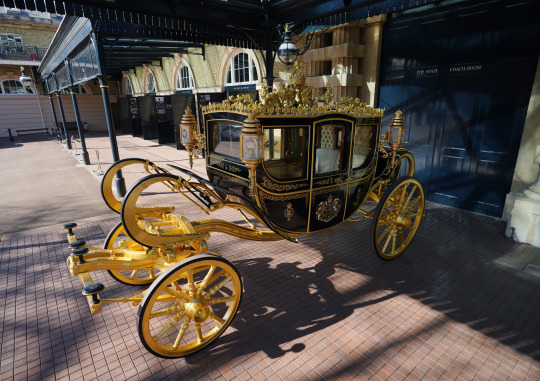
Their Majesties will travel in the Gold State Coach, which was commissioned in 1760 and was first used by King George III to travel to the State Opening of Parliament in 1762, and has been used at every Coronation since that of William IV in 1831.

19 notes
·
View notes
Text

100 Photos of Queen Elizabeth II: {36/100}
Queen Elizabeth II peers out of a window of Manchester Town Hall to view a Jubilee Garden during a visit to Manchester as part of her Diamond Jubilee Tour of the UK on March, 2012.
27 notes
·
View notes
Photo
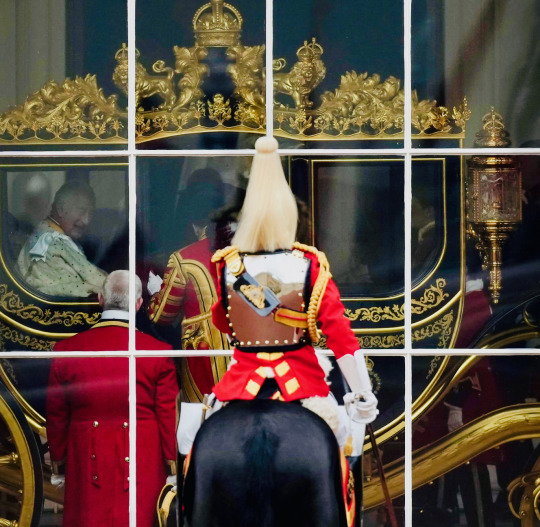
6 May 2023 | King Charles III travelling in the Diamond Jubilee Coach built in 2012 to commemorate the 60th anniversary of the reign of Queen Elizabeth II at Buckingham Palace ahead of the Coronation of King Charles III and Queen Camilla in London, England. The Coronation of Charles III and his wife, Camilla, as King and Queen of the United Kingdom of Great Britain and Northern Ireland, and the other Commonwealth realms takes place at Westminster Abbey today. Charles acceded to the throne on 8 September 2022, upon the death of his mother, Elizabeth II. (c) Christopher Furlong/Getty Images
#King Charles III#Britain#I haven't decided on a tag so here we are#2023#Christopher Furlong#Getty Images
118 notes
·
View notes